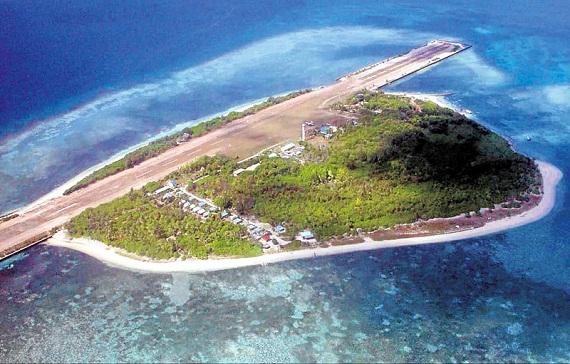HEADLINE
Philippines pushes case against China on South China Sea dispute
"A small Philippine island is at the forefront of the territorial dispute between the Philippines and China. "

China claims almost all the islands and atolls in the South China Sea, where the Philippines, Vietnam, Malaysia, Brunei and Taiwan also have overlapping claims.
This week, the Philippines presented its case at the United Nations-backed arbitral tribunal in The Hague, Netherlands, to contest China’s claims.
A small Philippine island is at the forefront of the territorial dispute between the Philippines and China.
Jofelle Tesorio and Ariel Carlos find out more.
It is mid-morning in this small fishing village. The fishermen are back from their morning haul.
Thirty year old fisherman Moises says he feels strongly about China’s claims.
“China should stop its illegal activities in the South China Sea because they are encroaching on our territories. The Spratlys is not theirs, it’s ours. It’s part of the territory of the Philippines. Even if you look at the map, Spratly islands belong to the Philippines,” he says.
The Spratlys are the group of islands and atolls in the South China Sea.
The Philippines claims some of the islands within its 200 nautical miles exclusive economic zone or EEZ. The chain is known locally as Kalayaan, or Freedom Islands.
Most residents stay at Pag-asa, the largest and most inhabited island.
Home to 114 people,the island has become the flashpoint of China’s aggressive expansion.
67-year-old Pag-asa resident Casimiro Saballero explains the situation to us from Palawan.
“Sometimes there are military ships. I think some are Coast Guard vessels from China. But the most who frequently go fishing around Pag-asa are Chinese fishing vessels and sometimes Vietnamese.”
Casimiro has been living on the island since 2001, where he raises livestock.
He likes living on the remote island because housing, electricity and food are subsidized by the government, he says.
But he fears that one day the Chinese military will take over.
“That’s one fear we have, that the Chinese military will invade us. But if it happens, I don’t think we can’t do anything. But it’s our territory. We shouldn’t give it up,” says Casimiro.
Kalayaan Mayor Eugenio Bito-onon says bigger Chinese vessels in the Spratlys are also using bullying tactics – such as tailing and harassing Filipino ships.
“In 2012, we were followed by a warship from Likas Island, about 70 nautical miles to Pag-asa until Pag-asa just about five nautical miles. In 2014, we were blocked, we were harassed in the darkness of the night, the wind was strong, the sea was very choppy,” says Major Bito-onon. “If we didn’t have a GPS and a satellite platter we would have a disaster. We were blown with horns.We were beamed with strong lights. Everybody was scampering for suits, for life vests.”
In recent years Beijing has rapidly built artificial islands in the Spratlys.
Mayor Bito-onon says that in the evening they can see the lights from one recently occupied island.
Because of increasing aggression from China in the South China Sea, the Philippines filed a case in the Hague-based Permanent Court of Arbitration in 2013.
Last month, the court ruled that it has jurisdiction to hear some territorial claims against China.
President Benigno Aquino III welcomed the decision.
“While the discussions in the arbitration tribunal are deep and complicated, I am very happy because we can say that the rule of law dominates here.”
For the second round of hearings, the Philippine delegation this week presented the merits of the case to the tribunal.
Among its arguments is the right of the Philippines over EEZ under the United Nations Convention of the Law of the Seas, or UNCLOS.
China has consistently refused to join the arbitration proceedings, saying it prefers to solve it bilaterally.
Mayor Bito-onon says talking to China bilaterally would be detrimental to the Philippines, especially as the Association of Southeast Asian Nations, or ASEAN, gains strength.
“ASEAN now is integrating and getting stronger. I think they’re beginning to adapt the multilateral negotiations rather than negotiate one by one. Because if you negotiate one by one, it goes to China’s favor who is becoming a bully and you are favoring a bully. And the strategy is very clear, divide and rule.”
The territorial row between the Philippines and China is likened to David and Goliath, China being the economically and militarily stronger. So far, China has insisted it will not participate in the legal proceedings.
Far away from the court arbitration, the small island of Pag-asa is directly feeling the tension.
Mayor Bito-onon, explains the view from the sea here.
“Like when we pass by Ayungin, we will be bothered by China Coast Guard there so we have to keep distance from Ayungin. And then we like to put up a pilot marine farm to support the livelihood of my people in terms of seaweeds and other marine culture but they have swarmed, saturated the target area that is very close to Pag-asa, with Chinese fishing boats destroying the coral reef.”
The mayor says that as long as China disregards international laws in the disputed area, resources in the area are in danger of being totally depleted.
- eng
- Jofelle Tesorio and Ariel Carlos
- South China Sea
- Dispute Philippines China
- Spratly Islands
Komentar (0)
KBR percaya pembaca situs ini adalah orang-orang yang cerdas dan terpelajar. Karena itu mari kita gunakan kata-kata yang santun di dalam kolom komentar ini. Kalimat yang sopan, menjauhi prasangka SARA (suku, agama, ras dan antargolongan), pasti akan lebih didengar. Yuk, kita praktikkan!